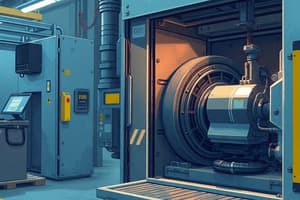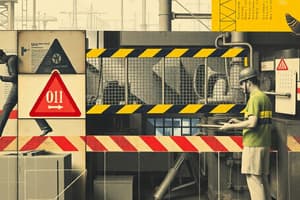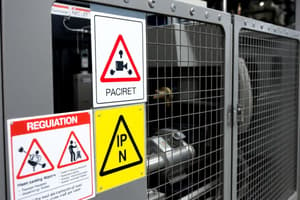Podcast
Questions and Answers
What is one of the primary purposes of good illumination in industrial settings?
What is one of the primary purposes of good illumination in industrial settings?
- To enhance aesthetics of the workplace
- To comply with legal requirements
- To improve safety and reduce accidents (correct)
- To save energy costs
Which of the following is a common method of controlling heat exposure in a workplace?
Which of the following is a common method of controlling heat exposure in a workplace?
- Increased workforce supervision
- Localized air conditioning (correct)
- Installing more windows
- Wearing safety uniforms
What aspect does the concept of 5S primarily aim to improve in a workplace?
What aspect does the concept of 5S primarily aim to improve in a workplace?
- Technological advancement
- Cost efficiency
- Housekeeping and organization (correct)
- Employee morale
What is the function of local exhaust ventilation in safety management?
What is the function of local exhaust ventilation in safety management?
Which of the following statutory provisions is likely to enhance safety when working at height?
Which of the following statutory provisions is likely to enhance safety when working at height?
What is a primary purpose of machine guards?
What is a primary purpose of machine guards?
What factor is crucial when selecting a guard for woodworking machinery?
What factor is crucial when selecting a guard for woodworking machinery?
Which of the following is NOT a recommended practice in manual material handling?
Which of the following is NOT a recommended practice in manual material handling?
What is the primary purpose of training operators in the use of lifting machinery?
What is the primary purpose of training operators in the use of lifting machinery?
What is a significant danger associated with electricity in a workplace?
What is a significant danger associated with electricity in a workplace?
Which aspect is crucial when calculating the safe working load of lifting equipment?
Which aspect is crucial when calculating the safe working load of lifting equipment?
What is a key factor in preventing tool accidents in the workplace?
What is a key factor in preventing tool accidents in the workplace?
Which safety feature is vital for portable electrical equipment?
Which safety feature is vital for portable electrical equipment?
Flashcards
Static Electricity Hazards
Static Electricity Hazards
Dangerous buildup of electrical charges on surfaces, often caused by friction.
Good Illumination
Good Illumination
Proper lighting that provides sufficient brightness and even distribution for safe and efficient work.
Pressure Vessel Safety
Pressure Vessel Safety
Safe design, construction, and operation of containers that hold fluids or gases under pressure.
Thermal Comfort
Thermal Comfort
Signup and view all the flashcards
5S Housekeeping
5S Housekeeping
Signup and view all the flashcards
Machine Guarding
Machine Guarding
Signup and view all the flashcards
Types of Machine Guards
Types of Machine Guards
Signup and view all the flashcards
Safe Lifting Techniques
Safe Lifting Techniques
Signup and view all the flashcards
Max Load for Manual Handling
Max Load for Manual Handling
Signup and view all the flashcards
Safety in Lifting Machinery
Safety in Lifting Machinery
Signup and view all the flashcards
Hand Tool Safety
Hand Tool Safety
Signup and view all the flashcards
Electrical Hazards
Electrical Hazards
Signup and view all the flashcards
Electrical Safety Practices
Electrical Safety Practices
Signup and view all the flashcards
Study Notes
Machine Guarding
- Statutory Provisions: Regulations outline principles for machine guarding.
- Types of Guards: Various guard types exist, with design and selection crucial.
- Specific Machinery: Special guarding needed for woodworking, paper, rubber, printing machines, and machine tools.
- Built-in Safety Devices: Discuss the importance of integrated safety features.
- Guard Maintenance: Procedures for regular guard maintenance and repair are vital.
- Incidental Safety Devices: Importance of additional safety items and tools is emphasized.
- Workplace Design: Safety in the layout and design of plants and work areas are critical to prevent accidents.
Manual Handling and Storage
- Hazards: Manual handling presents specific risks.
- Effort Avoidance: Techniques to prevent excessive physical exertion during lifting and carrying.
- Lifting Techniques: Correct kinetic methods for safe material handling.
- Load Limits: Maximum safe weights for manual lifting and carrying are important to avoid injury.
- Object Handling: Strategies for handling objects of different sizes, shapes, and weights safely.
- Accessories: Appropriate use of accessories for manual handling of materials.
- Storage: Proper storage of materials plays a significant part of preventing accidents.
Mechanical Handling
- Lifting Machinery: Safety considerations for cranes, elevators, conveyors, dumpers, and pay loaders apply during design, construction, and testing.
- Operator Training: Training for safe operation, signaling, inspection, and maintenance of lifting machinery is crucial.
- Power Trucks and Tractors: Specific safety features in design, operation, inspection, and maintenance are essential.
- Lifting Tackles: Knowledge of chain slings, rope slings, fiber, wire rings, hooks, shackles, swivels, and eye bolts is important.
- Safe Working Load: Calculating the safe working load of lifting equipment is critical.
Hand Tools and Portable Power Tools
- Tool Accidents: Main causes of tool accidents and accident control methods.
- Tool Control: Importance of centralized tool control systems, and purchase, storage, and supply methods.
- Tool Inspection and Maintenance: Inspection, maintenance, repair, and crucial examination of tools is a major safety parameter.
- Tool Failure: Detectable causes of tool failure, and the need for tempering, safe sharpening, and dressing certain tools is imperative.
- Tool Handles: The importance of proper tool handles.
- Tool Types: Various hand tools (metal cutting, wood cutting, etc.) and portable power tools are discussed regarding their usage and safety.
Electrical Hazards
- Electrical Dangers: Understanding electrical dangers such as amperage, voltage, and safe distances from power lines.
- Conductor Protection: Adequate conductor capacity and protection from overload or short circuit.
- Fault Protection: Importance of earth fault protection systems are discussed.
- Tests: Earth, insulation, and continuity tests are critical to ensure circuit safety.
- Overvoltage Protection: Protection against overvoltage hazards related to borrowed neutrals.
- Portable Electrical Apparatus: Flame-proof portable equipment and precautions for usage.
- Electrical Equipment: Precautions related to selection, installation, maintenance, and use of electrical equipment.
- Static Electricity Control: Controlling hazards associated with static electricity.
- Electrician's Role: Electricians are pivotal in preventing electrical accidents.
- Electrical Regulations: Relevant provisions of the Indian Electricity Act and Rules.
Industrial Lighting
- Lighting Purpose: Purpose of lighting in workplaces and the advantage of proper illumination.
- Safety: Lighting and workplace safety are intertwined.
- Lighting and Work: Lighting directly impacts the type of work and efficacy.
- Artificial Lighting: Various artificial light sources and their types.
- Good Illumination Principles: Principles for achieving optimum illumination levels.
- Illumination Standards: Recommended minimum standards of illumination.
- Lighting Installation: Process and maintenance of lighting installations.
- Lighting and Colour: Importance and impact of colour in lighting.
Pressure Vessels
- Statutory Provisions: Regulations for safety of pressure vessels (fired and unfired).
- Testing Requirements: Testing procedures for pressure vessels are crucial for safety.
- Safety Aspects: Aspects to consider for safety design and construction of pressure vessels.
- Boilers: Boiler safety precautions and operational safety are discussed.
Ventilation and Heat Control
- Ventilation Purpose: Purpose of ventilation and its role in regulating the thermal environment.
- Thermal Environment Measurement: Methods for measuring and evaluating thermal conditions.
- Heat Regulation: Human physiology and heat regulation.
- Thermal Comfort: Defining and achieving thermal comfort levels.
- Heat Stress Indices: Using indices to measure heat stress.
- Thermal Limits: Comfort and safety limits relating to heat exposure.
- Ventilation Types: Natural, mechanical, air conditioning, and process ventilation.
- Heat Exposure Controls: Methods for managing and preventing heat exposure.
Housekeeping
- 5S Concept: Importance of the 5S system in workplace organization.
- Management Responsibility: Management's role in maintaining a safe and organized workplace.
- Safety Engineers' Involvement: The crucial contribution of safety engineers in housekeeping.
- Planning and Follow-up: Proper planning and follow-up for good housekeeping is essential.
- Cooperation: Need for cooperation amongst employees for effective housekeeping.
- Unsafe Housekeeping Examples: Examples of poor housekeeping practices and their consequent risks.
- Scrap Disposal: Proper disposal of scrap.
- Spill Prevention: Methods to prevent spills.
- Marking: Marking of walkways, and using colours for good housekeeping.
- Clean Up Campaigns: Significance and methods for efficient clean-up.
- Employee Assignments: Assigning tasks to employees for maintaining cleanliness.
- Inspection: Importance of inspection and checklists.
- Good Housekeeping Results: Benefits of good housekeeping.
Special Precautions
- Working at Heights: Specific precautions for work at heights and work permit requirements.
- Confined Spaces: Specific precautions for work in confined spaces and work permit requirements.
Laws and Regulations
- Relevant Acts and Rules: Laws and regulations relating to Factories Act, Indian Electricity Act, Explosive Act, Gas Cylinder Rules, covering safety aspects in specific industries.
Studying That Suits You
Use AI to generate personalized quizzes and flashcards to suit your learning preferences.
Description
This quiz covers essential principles of machine guarding and safe manual handling techniques. It includes statutory provisions, types of guards, specific machinery considerations, and the importance of integrated safety devices. Additionally, it addresses the hazards of manual handling and techniques to prevent injury during lifting and carrying.




